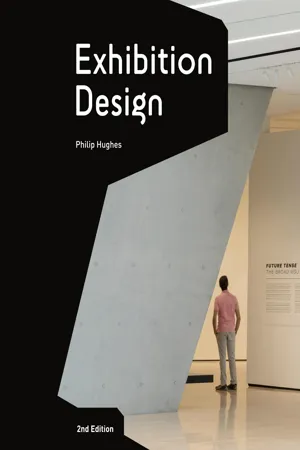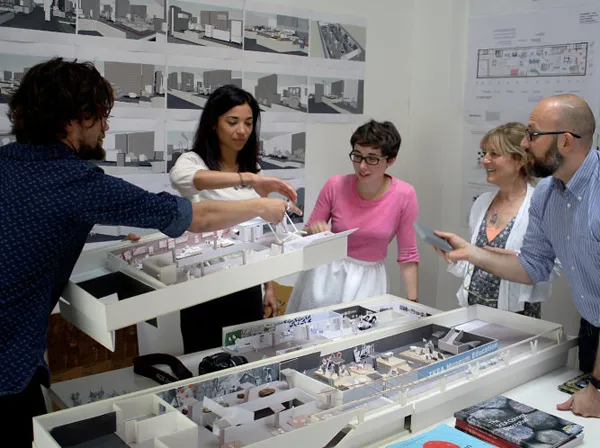![]()
This chapter describes the ideal brief, how it is formulated and the various aspects of exhibition planning that it should cover. These include the target audience, the context or narrative in which exhibits will be seen, and the way in which the theme of the exhibition should be interpreted. A brief also highlights the need for the client to provide the designer with all the information necessary to achieve a successful outcome.
At the beginning of every project, designer and client need to develop a shared understanding of a project. This understanding needs to be both creative and practical, describing what is expected, as well as the creative opportunities. Typically, a good brief is recorded and provides a reference point for future developments, helping both client and designer understand whether, as a project moves forward, they have strayed from the initial intentions, or whether assumptions have changed. Successful projects start with a good, clear initial briefing, but this will often evolve as client and designer explore the potential of a given project.
Ultimately, the mark of a successful brief is a successful and creative project. The skill of the client in creating a design brief cannot be underestimated—the better the brief, the better the working process and the realized project. Accurate attention to information such as budgets, costs and programme is essential, while similar attention to less tangible elements such as themes and content will likewise lead to relevant, thought-provoking creative responses. Brief-writers often ask how prescriptive a brief should be. Good projects can be achieved with both loose and tightly prescriptive briefs. However, if the designer is to meet the expectations of the client, it is really important that the client is clear about what those expectations are. If a brief does not communicate intentions clearly, the designer will likely waste a lot of time and effort trying to discern them.
How specific should a brief be?
Some briefs can be too prescriptive. If the client specifies what they would like to see in their exhibition too precisely, they effectively take design decisions into their own hands and deny themselves the opportunity to use the designer’s expertise. A brief that is too vague, on the other hand, runs the risk that the designer may waste time working on issues that are not relevant to the task in hand.
All in all, if the client has good ideas that they feel should be considered, they should put them up for discussion at the outset, but be willing to take the designer’s advice on whether they are appropriate. This saves time and avoids the common situation where the client has an idea but waits to see whether the designer comes up with the same one, and is disappointed when they do not. The best briefs are specific about objectives, learning outcomes and available assets, such as collections—this leaves the designer free to inflect the content in the best way, and consider which delivery techniques might be best for which type of content.
As a designer, it is essential to test your understanding of the brief by questioning the client, investigating scenarios and generally probing the brief’s soundness. If the client has not described the nature of the task properly and some aspects do not make sense, ask questions, even at the risk of appearing naive.
What kind of language should a brief use?
A brief usually contains lots of dry factual information, such as scope, budget and programme, and there is no point in dressing this up. However, it should also always contain some emotive language to convey the importance of the project—why it is exciting and worthwhile. Creative design often thrives on the association of words and images, so clever, funny and evocative language can be used to stimulate the designer’s imagination. The language used can also provide the designer with valuable insights into the client’s frame of mind, which can, in turn, shape a better working process and indicate the most appropriate forms of communication. For example, formal clients may prefer well-prepared materials, presented less frequently, while less formal clients may wish to see working sketches and early ideas at more regular intervals.
The briefing process is not limited to written documents, however. Creative immersion in the idea of a project is essential. A visit to a museum vault, a client’s factory, cultural visits undertaken together and joint workshops will all help convey ideas and feelings, and enable a designer and client to develop a successful working relationship.
Strategy
There are myriad ways to set out the necessary components of a brief, and these are listed below. Large projects may feature all of these elements and more, but smaller projects will often omit any number of these if they are not relevant.
Institutional or company objectives
Most companies and museums have a list of written objectives or institutional goals tailored to their overall mission, and it is incredibly helpful to see these, particularly when working for a client for the first time, as these will govern the development of the experience. These objectives will have been carefully considered, and will often have a strong influence on the daily work of the client body. These aims often benefit from some explanation, though—who originated them and how they evolved. For museums, these statements are a key point of difference, indicating to staff and visitors how they distinguish the experiences they offer from their competitors.
Messages and outcomes
Most exhibitors have values and ideas—often referred to as “key messages”—that they want to communicate to their audiences as part of an overall strategy. These are typically altered and updated more frequently than institutional objectives, and they often mirror short-term campaigns. Museums can use these messages to help them pursue, for example, strategic educational initiatives to enhance students’ understanding of science, natural history or history. Commercial exhibitors will often have strategic goals that explain the competitive strengths and unique advantages of their current offer. Related but slightly different are visitor outcomes. These describe the ideas of impressions the client wants the audience to take away from their visitor experience. For example, a natural history exhibition about insects might be intended to leave schoolchildren with the idea that “the bugs in my house are really interesting”, or “science can be fun”. It can be really helpful to state intended “visitor outcomes” as well as “visitor messages”, as there is a critical difference between delivering messages (saying that “science is fun”) and designing an experience that creates an understanding in the mind of the visitor (having visitors say “science is fun” after their visit). The former is more straightforward; the latter is a more complex outcome to achieve, but ultimately a more rewarding result. Visitor outcomes can be tested through audience surveys, which can help designer and client understand how close they are to reaching their targets.
The subject or content of an exhibition is sometimes tied to a wider campaign or, in the case of commercial exhibitions, to wider branding strategies. A coordinated approach that enables an exhibition both to gain publicity and to help broaden and deepen a wider branding strategy is sometimes required. This kind of thinking is less relevant for museums than it is for commercial exhibitions, where the explicit aim is to enhance brand perception. Commercial exhibitors often have extensive reports detailing areas where they need to heighten or shift visitor perceptions of their brand. This information can be especially useful, and should be included in briefs for commercial exhibitions so that the designer can maximize any opportunities for linking with existing branding, marketing or communications. Exhibition content also often connects with, or gives insight into, topics on school or university curricula. For many national institutions, particularly museums of science and natural history, these links are very carefully considered. If an exhibition subject directly addresses an aspect of learning—say “optics” or “how machines work”—the museum can play a powerful role in expanding and deepening student learning through live demonstrations and showing key historical objects that may have been previously explained or introduced in the classroom. Where the client wants to make these links, it is important to explain in the brief exactly what the links are, and what students are expected to take away from their experiences. This kind of information has an impact not just on the spatial storytelling aspect of an exhibition, but also on design features, such as gathering spaces for groups, or capacity for live demonstrations, to give two examples.
Sustainability
Sustainability features in many exhibition design briefs, so it is a good idea to establish from the outset what this means in the context of the project. Sustainability can relate to two distinct areas in exhibition design: environmental and financial. Environmental sustainability affects the materials used in constructing the exhibition, and may even affect the working process, impacting on travel, for example. Financial sustainability refers to the business plan or business objectives a client may have when developing an exhibition, and will impact upon such factors as how many visitors can occupy the space at any one time, or whether there is a retail or café space.
Ambitions for sustainability should be defined early on in the project, ideally by the client—how they expect sustainable principles to be applied, and to what level. There are a number of official bodies that provide benchmarks for environmentally sustainable projects: BREEAM (Building Research Establishment Environmental Assessment Method) in the UK and LEED (Leadership in Energy and Environmental Design) in the US are examples. Whereas architects have become familiar with sustainable working practices and standards, examples of the application of sustainable exhibition design practices are fewer, although large project teams often include sustainability consultants to help realize sustainability criteria.
Masterplanning
Very often exhibition designers are asked to create “interpretive masterplans”. These address the need to plan links between disparate content/gallery areas, and often encompass an entire site, or a large section of a site. A completed interpretive master plan shows potential visitor routes between galleries, illustrates logical content sequences (such as a chronological or thematic approach) and might illustrate a range of costed options to help the client decide how best to use their buildings and galleries within a given budget. These studies are necessary to make integrated visitor experiences that are consistent with a pre-determined, logical, carefully devised narrative.
Interpretive masterplans might also make recommendations for the placement of cafés or gift shops along the route to maximize the client’s revenue and provide comfort for visitors. As the planning of new facilities and the re-thinking of existing facilities often requires new marketing or operational strategies, these masterplans can be accompanied by marketing or operational plans produced by external consultants.
Marketing
Exhibitions are undoubtedly more successful when they are accompanied by large landmark events such as lecture series, book launches, and radio and TV programmes. If events are planned around the opening of an exhibition, it is helpful to make exhibition designers aware of this as it may affect the focus of the exhibition. Increasingly exhibition content is shared across a number of platforms, including social media, providing new ways to gain public attention for museum content and attract new audiences. Forwardthinking exhibitors have also begun to mix virtual and physical encounters that enable people to share in the experience of being in the exhibition, and allow visitors at the exhibition to see digital input from outside. Key visitor attractions from a museum or exhibition experience provide leverage for marketing and social media, and can sometimes be designed to provide maximum exposure to social media. If a client has these expectations, they should be communicated in the brief.
Ralph Appelbaum Associates, London, UK, 2014. Creative and rich design environments stimu...



